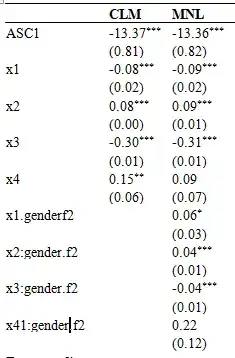I’m using DCE with unlabelled alternatives, 9 choice set with 3 alternative each (2 option and Optout alternative), described with 4 attributes.
I've started with a conditional logit (with only alternative specific constants).
mydata$ASC<-ifelse(mydata$alt==3, 1, 0)#To create the ASC for the optout alternative.
mydata<-mlogit.data(mydata,choice = 'Y', shape = 'long',varying = c(5:8,48),
id.var = 'Indiv', chid.var = 'CASE', alt.var = 'alt')#To prepare the data for mlogit.
CLM<-mlogit(Y~ 0+ ASC+ x1+x2+x3+ x4, data=Tlemcen)
Then, I wanted to add individual specific variables (characteristics of decision makers). Since alternatives are unlabelled, I use interaction between alternative and individual specific variables.
mydata$gender.f<-as.factor(mydata$gender)#define gender as factor variable.
MNL<-mlogit(Y~ 0+ x1+x2+x3+ x4+x1:gender.f+x2:gender.f+ x3:gender.f+ x4:gender.f, data=mydata)
I have notice however, that the parameters estimate of the attributes variables change when I add those interactions.
So I have some questions:
-Why does estimates parameters of my attributes change when I add an interaction to the model, and how to interprete those parameters ?
